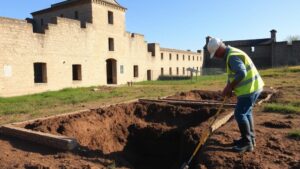Exploring Battlefield Trenches for Artifacts and Personal Effects
Exploring Battlefield Trenches for Artifacts and Personal Effects
The study of battlefield trenches serves as a fascinating intersection of archaeology, history, and the collective memory of warfare. Trenches, notably employed during the First World War, provide a wealth of artifacts and personal effects that illuminate the experiences of soldiers and the realities of war. This article examines the significance of trench exploration, the methodologies employed, notable findings, and the ethical considerations involved.
The Historical Context of Battlefield Trenches
Trenches became a prominent feature of warfare during the First World War, particularly on the Western Front, where prolonged stalemates led to the construction of intricate networks of defensive systems. By 1916, it is estimated that over 1,500 miles of trenches existed, a testament to their strategic importance. The conditions were often dire; soldiers faced not only enemy fire but also diseases, psychological stress, and harsh living conditions. Understanding the layout and function of these trenches is crucial for archaeologists who seek to recover the remnants of this tumultuous period.
Methodologies for Exploration
Trench exploration involves several methodological approaches, blending archaeology with historical analysis. e include:
- Surveying: A non-invasive technique where archaeologists map the area using tools such as ground-penetrating radar (GPR) to locate potential artifacts without disturbing the site.
- Excavation: Carefully digging selected areas to recover artifacts while documenting the stratigraphy, which can reveal the context in which items were used.
- Documentation: Systematic recording of findings, including photographs and notes on location, condition, and associated materials, which is critical for future analysis.
For example, the excavation of the trenches at Verdun has yielded a trove of artifacts, including weapons, personal items, and everyday objects, which provides insight into the daily lives of soldiers and the brutal conditions of trench warfare.
Artifacts and Personal Effects: What They Reveal
The artifacts found within trenches can range from military equipment to personal belongings, each with its own story and historical significance. Notable categories include:
- Military Artifacts: Items such as spent ammunition, helmets, and uniforms reflect the technological advancements and the harsh realities of combat.
- Personal Items: Letters, photographs, and personal effects like watches and wallets offer a glimpse into the lives of soldiers, illustrating their hopes and fears.
- Everyday Objects: Tools, cooking utensils, and remnants of food containers help reconstruct the daily experience of life in the trenches.
For example, the discovery of a soldiers diary in a trench can provide invaluable firsthand accounts that contextualize historical events, adding personal dimensions to the broader narrative of the war.
Case Studies: Notable Discoveries
One of the most significant case studies in trench archaeology is the excavation at the Battle of the Somme. Researchers discovered a trench used during the battle and recovered hundreds of artifacts, including intact gas masks and soldiers letters. e findings not only advanced historical understanding but also sparked public interest and remembrance efforts.
Another compelling case is the exploration of the Canadian trenches at Vimy Ridge, where thousands of artifacts, including personal belongings of soldiers, have been unearthed. These findings have contributed to the national narrative of Canada’s participation in the war and have enhanced the understanding of military history from a Canadian perspective.
Ethical Considerations in Artifact Recovery
While trench exploration can yield valuable historical insights, it is accompanied by ethical concerns. The following must be considered:
- Respect for the deceased: Archaeologists must approach sites with sensitivity, ensuring that the remains of soldiers and their belongings are treated with respect.
- Ownership and provenance: Disputes can arise regarding who owns the findings and how they should be preserved or displayed.
- Educational outreach: The importance of sharing findings with the public, including educational programs that honor the soldiers and illuminate the historical context.
Adhering to ethical guidelines allows for responsible exploration that contributes to both academic knowledge and public engagement with history.
Actionable Takeaways
For individuals interested in participating in or supporting archaeological efforts focused on battlefield trenches, the following steps can be taken:
- Engage with local historical societies or universities that conduct trench archaeology.
- Consider participating in volunteer excavations to gain hands-on experience while contributing to historical preservation.
- Stay informed about ongoing research and developments in battlefield archaeology through publications and documentaries.
Exploring battlefield trenches not only serves to recover physical artifacts but also to reconstruct the narratives of those who experienced war. Through ethical practices and collaboration, we can preserve and educate future generations about the profound impacts of history on modern society.



